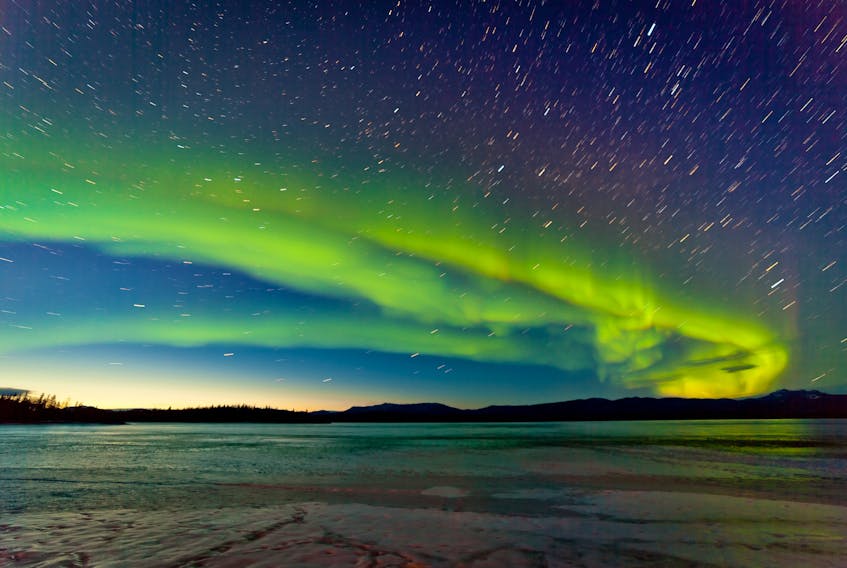The Milky Way isn't the only band of light in the night sky. For those who live in or close to the Earth's north polar region, the sight of the aurora borealis (often called the Northern Lights) are a fairly common sight, especially on clear Arctic nights.

It was Italian astronomer Galileo who, in 1619, first coined the term "aurora borealis," derived from Aurora - the ancient Roman goddess of the dawn, and Boreas - the ancient Greek god of the north wind. In the southern polar region, these bands of light are called the aurora australis (New Latin for southern dawn) or "Southern Lights."
Without going into too much scientific detail, auroras are, essentially, light produced when charged particles (electrons, protons and alpha particles) in the sun's solar wind (the rarified stream of hot plasma constantly emanating from the sun's upper coronal atmosphere) precipitate into the Earth's upper atmosphere at our planet's north and south magnetic poles.
While the solar radiation from the sun is more or less constant (thus some level of auroras are usually always visible on clear nights in the polar regions), there are times when, during periods of heightened solar activity (sometimes called "solar storms" in the form of solar flares or coronal mass ejections), large masses of gas and plasma are spewed from the sun out into space. If these larger concentrations happen to intersect Earth, the resulting geomagnetic storm in the Earth's upper atmosphere often produces magnificent and long-lasting auroral displays.
Although auroras are usually associated with the high-latitude areas of Earth's Arctic and Antarctic regions, they can and have been seen in the night sky in areas closer to the equator. Depending on the intensity of the geomagnetic storm, auroras can spread quite far from the polar regions - in North America, auroral displays have been viewed as far south as northern California in the west, Colorado in the central US, and North Carolina on the east coast, though this is very rare.
Auroras come in different colours and forms. The colours are generated when the charged solar particles slam into the elemental gases in the Earth's upper atmosphere, causing the elements to become ionized (the atoms or molecules acquire a positive or negative charge by gaining or losing an electron), the resulting energy generation resulting in the emission of various hues of coloured light - red (usually appearing at higher altitudes) from atomic oxygen atoms in low concentrations; green (the most common colour seen) from atomic oxygen in higher concentrations at lower altitudes; blue (rare) from molecular nitrogen; and, at times, hues of pink, yellow, orange and purple, the result of a mixture of the other three colours.
Auroras appear at an altitude of approximately 90-150 kilometres above the Earth's surface, and primarily come in four main forms, which may change, disappear, and reappear at any point throughout a particular display - faint glows near the horizon; cloud-like patches ; arcs; and rays or curtains. It is actually possible to hear the hiss or crackle of auroras, the sound being generated when the charged particles precipitating into the upper atmosphere hit a temperature inversion layer (colder air mass near the ground is overlaid by a layer of warmer air) about 70 kms above the Earth's surface.
Though the sun's surface activity follows a rough 11-year cycle (called a solar cycle), its intensity varies greatly from month-to-month, year-to-year, and cycle-to-cycle. The variations are enough that one cannot predict with any real accuracy exactly when a solar storm will occur, if and when it will intersect Earth, and if the resulting geomagnetic storm will be intense enough to generate a significant auroral display. One online site, which gives a half-hour notification of the potential for a heightened auroral display, plus an indication of how far south (or north) the display may be seen, is https://www.swpc.noaa.gov/products/aurora-30-minute-forecast; other sites give larger time-lag predictions (e.g., hourly, daily, weekly).
This week’s sky
- Mercury (magnitude -0.6) is due to reach inferior solar conjunction (when it passes in front of the sun as seen from Earth) on Feb. 25, and, thus, is currently too close to the sun to be seen.
- Venus shines brightly at mag. -4.12 high in the southwest sky around 6 p.m., setting shortly before 10 p.m. Look for the thin, waxing, crescent moon to the left of Venus on the evening of Feb. 27.
- Mars (mag. -1.5) appears, as it has done for the past couple of weeks, in the southeastern pre-dawn sky shortly after 4 a.m., fading as the eastern sky brightens shortly after 6 a.m.
- Jupiter (mag. -1.9) follows Mars up into the southeastern pre-dawn sky shortly before 5 a.m., fading from view shortly before 7 a.m.
- Saturn sits very low to the southeastern horizon about two hours before sunrise and may not be visible.
- Weather permitting, try to spot the one-day-old, waxing, crescent moon low in the west-southwest sky on the evening of Feb. 24 (the new moon was on Feb. 23rd); you will have to be quick, as it sets shortly before 7 p.m.
Until next time, clear skies.
Events:
- Feb. 24 – One-day-old crescent Moon in west-southwest sky at dusk
Glenn K. Roberts lives in Stratford, P.E.I., and has been an avid amateur astronomer since he was a small child. His column, Atlantic Skies, appears each week. He welcomes comments from readers, and anyone who would like to do so is encouraged to email him at [email protected].








